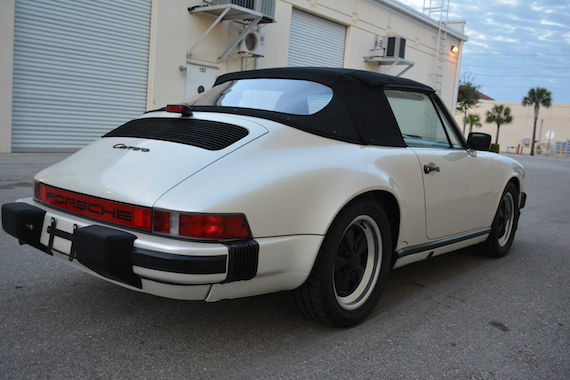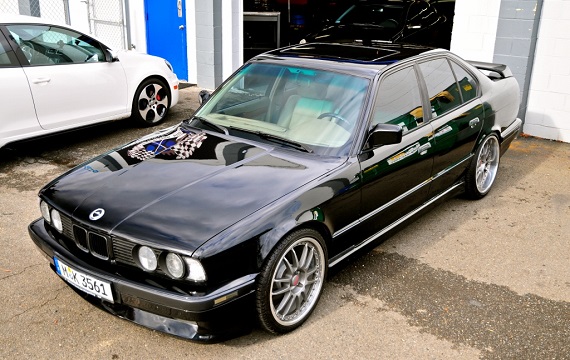Following from yesterday’s early Porsche 930 here we have an example from the other end of the spectrum: a Silver Metallic 1989 Porsche 930, located in California, with 51,300 miles on it. 1989 marked the other significant point in the 930’s evolution as Porsche finally fitted the car with a 5-speed manual transmission in place of the 4-speed that had been standard throughout the model’s life. Oh, and it was the last year of the 930’s production. That makes these models highly regarded on the collector market and, as we can glean from the asking price here, quite a bit more valuable than some of the preceding years. It is these two ends of the 930 spectrum, the early 3.0 liter cars and the final year G50-equipped cars, that are commanding the most value these days and it has been interesting to compare the relative values of each. 1989 signaled the end of an important era for Porsche, and the 911 in general, as the cars produced over the previous decade had cemented the long-term viability of the 911 within Porsche’s ranks. It would also be the same year the 964 was introduced, a model that propelled the 911 forward and brought with it significant changes. As a way to say goodbye to the classic 911 design, the 5-speed 930 made for a nice departure.
Month: January 2015
Survivors are a mixed bag; for whatever reason, it seems that most often it’s not the most desirable cars that pop up as survivors but the more odd, off color base models that appear. A few weeks ago I looked at a 1989 Volkswagen Golf GL; clean, original, and rare to see these days, it’s unfortunately not the car most are looking for. Back up a generation to the Rabbits, though, and more people seem interested in them. Perhaps it’s because few remain in clean, original shape – or perhaps it’s because they have more character than the second generation Golf. Either way, there’s no denying the charm of seeing a now 32 year old Rabbit looking like it just rolled out of a dealer service area in 1987:
CLICK FOR DETAILS: 1983 Volkswagen Rabbit L on eBay
4 CommentsIt’s rather amazing that the Porsche 911 went almost a full 20 years without a full on convertible option, relying on the Targa variant to address the wants and desires of those seeking al fresco motoring. In 1983, the 911SC Cabriolet debuted, quickly replaced in 1984 with the introduction of the Carrera 3.2 range. While most hardcore enthusiasts prefer the rigidity of the coupe variant, there is something about the Cabriolet that conjures up images of carefree jaunts by the seaside, enjoying the raspy tune from the flat-6 mill swung aft of the rear axle line. This 1986 911 Cabriolet is painted in an uncommon shade of Perlmuttweiss Mica over black leather with white piping.
Click for details: 1986 Porsche 911 Cabriolet on eBay
2 CommentsIn the 1980s and early 1990s, Dinan was still on the cutting edge of performance tuning. As with Reeves Callaway, Steve Dinan had started turbocharging BMWs to create supercar-slaying sedans and coupes. At that point, Dinan was a lesser-known tuner than the likes of Alpina and Hartge, but the results of their turbocharging the S38 in the BMW M6 notably gained the car the nickname “The Annihilator”. That should tell you something of the level to which Dinan Cars brings their creations to whilst retaining the original attributes of the base car. It’s a special combination that resulted in Dinan being incorporated into the BMW dealer network; today, cruise down to your dealership and you can buy Dinan products and software upgrades for just about any model and retain your warranty. Because of that connection, an appreciation for early Dinan cars continues to grow though in general they remain more affordable than their German tuner counterparts. They are, however, just as rare to come across – especially when they come in the condition of today’s 1991 535i, one of the last of Dinan’s inline-6 turbo creations:
CLICK FOR DETAILS: 1991 BMW 535i Dinan Turbo on GCFSB
6 CommentsAn early Porsche 930 is a truly special vehicle, not just for its sheer performance but for its development and ultimate showcase of what Porsche was capable of producing. While initially intended to follow in the footsteps of the Carrera RS as a lightened 911 designed to meet homologation requirements, plans for the 930 shifted as those requirements changed and the car became an opportunity for Porsche to produce a car that melded a high degree luxury with blistering performance. Porsche could now compete with the likes of Ferrari. During the early years, from 1975-1977, the 930 changed little featuring a turbocharged 3.0 flat-six mated to a 4-speed manual transmission. The greatest change then came in 1978 when displacement was increased to 3.3 liters and an intercooler was integrated into the redesigned spoiler. My preference, purely from an aesthetic point of view, has always been for the 3.0 liter cars for the simple reason that the whale tail fits the lines of the car almost perfectly, while the tea-tray of the 3.3 liter cars looks slightly clunky. It’s a minor difference, but one that always stands out to me. The example here comes from that early 3.0 liter period: a rare sunroof delete, European, Grand Prix White 1977 Porsche 930, located in Los Angeles, with 21,787 miles on it.





